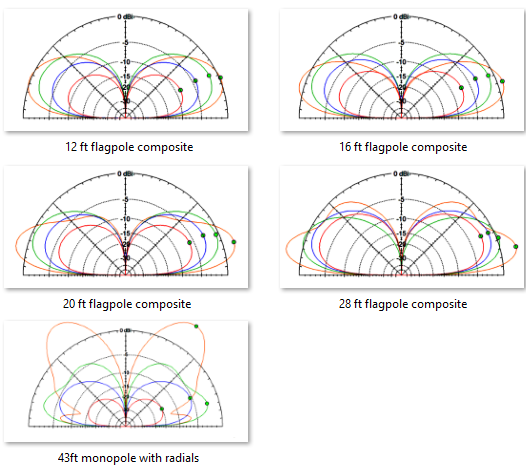Greyline VDA vs. 43' Vertical: Why Smarter Beats Taller
Smarter, Not Taller: Greyline VDA vs. The 43' Vertical
In amateur radio, there's a common belief that a taller antenna is always a better antenna. The 43-foot vertical, a popular non-resonant design, is a product of this belief. But is it true? When you compare a brute-force solution with a highly-engineered one like the Greyline VDA, the data shows that design efficiency and not surpassing 5/8ths wave in height is far more important than height alone.
Efficiency: Off Center Fed vs. Ground Fed
At the core of antenna performance lies a crucial distinction in engineering philosophy. A conventional 43-foot vertical employs a ground-fed design, which fundamentally relies on an extensive radial field to mitigate ground losses and achieve a proper match.
The Greyline VDA represents a more elegant and efficient approach. By utilizing an Off-Center Fed (OCF) design, we elevate the feed point to approximately 20% of the radiator's height. This strategic placement eliminates the requirement for a complex and often inefficient radial system entirely.
While both antennas are non-resonant systems requiring an external ATU, their performance profiles are dramatically different. The 43-foot vertical can be effective on lower frequencies (30-80M), but its electrical length becomes a liability on the higher bands. From 20M to 10M, its radiation pattern collapses, sending your signal skyward instead of toward the horizon for valuable DX contacts.
In contrast, the Greyline VDA is engineered for consistent, low-angle radiation across the spectrum. Our elevated feed point, meticulous system integration, and freedom from radial field losses ensure that maximum power is converted into a highly effective signal. This is the definition of smart, strong, and elegant performance.
The Data: Greyline vs. 43' Vertical
Let's look at the models. This comparison pits our 12' - 16' - 20' - 28' Greyline VDAs against a 43' vertical, both modeled over average ground and including typical matching losses.

Analysis: A Tale of Two Signals
-
Real-World Signal: Look at the orange lines (15M) for example. As we get longer than 1/4 wave in height we see 15M increase in potency on the horizon as the angle lowers too. That's dB gain! Note the 12' even holds it's own on 80M. Impressive. One Greyline customer reports working 160M with the 16' DX Flagpole
-
Radiation Pattern: Notice the clean, low-angle pattern of the Greyline antenna. This is the result of a balanced, efficient VDA design that requires no radials. In contrast, see the 43' pattern starts to go low angle to the horizon, which we want to see, but is pulled up, way up on 15-20M. That's not DX. The Greyline VDA puts a stronger, more efficient, consistent signal on the air across these key DX bands. Remember, there is a too high, so beware of this.
-
Practicality: Beyond the numbers, the Greyline is a free-standing, HOA-friendly flagpole that requires no guy wires and a fraction of the footprint.
The Verdict: Choose Smart Performance
Height is an advantage only when it's part of an efficient, well-engineered system. The 43-foot vertical is a compromise that trades all bands for a few bands. The Greyline VDA is an optimized solution that delivers superior, real-world DX performance in a stronger, smarter, and more elegant package. XYL's approve!
